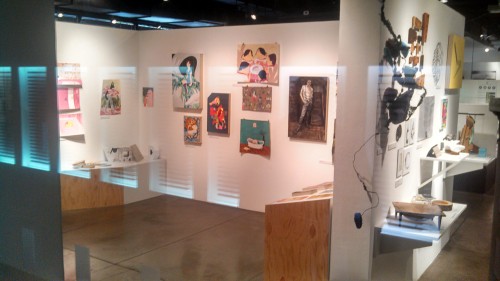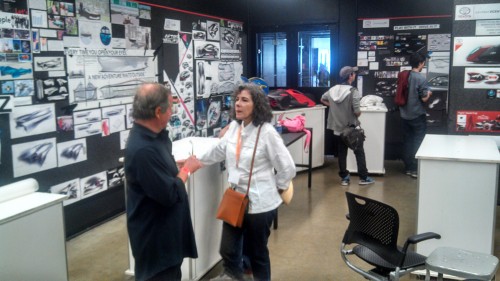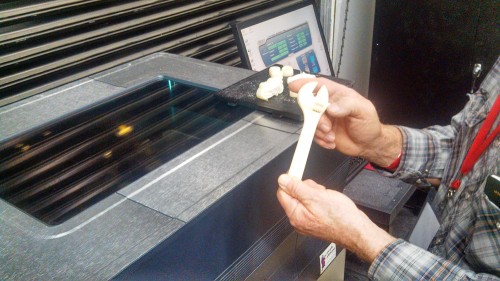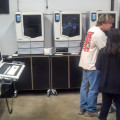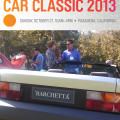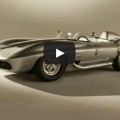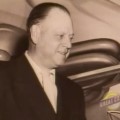2013 Art Center Car Classic Highlights and Exhibitor Information
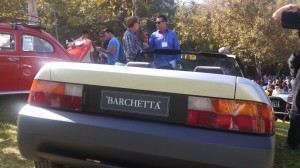
Scott speaks on the record as one of Art Center Car Classic Highlights about the Ghia Barchetta and its extremely influential nature as a sports car design of the 1980’s.

Jay Leno was kind enough to bring his 1991 Mclaren F1 to the show! Why it was the only car roped off among the heathen hordes who descended upon Pasadena this fine Sunday was never explained and remains a mystery.

All I kept thinking when walking by this was “McFly!?!?!?!”, with the caveat of Biff knocking on Marty’s skull repeatedly. And I passed this car maybe a dozen times during the day. I watched the Back to the Future in full a day later just to get it out of the way.
Exhibitors
This year’s Car Classic celebrates the cars, bikes, aircraft, boats, and other vehicles that have been Inspired by Nature —the sculpture, form and fluidity to move through water and air that has inspired designers in the shape, function and structure of their designs over the years.
INSPIRED BY NATURE

1959 Chevrolet Corvette Racing Stingray
General Motors Design
The Corvette Stingray was a privately funded concept car that formed a basis for the second (C2) generation Corvette Sting Ray. The Stingray racer-concept car was designed by Art Center alumnus Pete Brock, the youngest designer to work at GM at that time, Bill Mitchell, GM Vice President of styling, and another Art Center alumnus, Larry Shinoda in 1957. The low, flat profile resembles its aquatic namesake.

1963 Chevrolet Corvette Stingray split-window
Bill Galloway
The Stingray racer body design strongly influenced the styling of the next generation Corvette, which saw production as the 1963 “split window” model. The car was based on Peter Brock’s original coupe sketch, and was refined by Larry Shinoda, again keeping the low stingray profile.

1961 Chevrolet Corvette Mako Shark
General Motors Design
Also inspired by the 1959 Stingray racer, the XP-755 concept car, also known as the Mako Shark, was designed by Art Center alumnus Larry Shinoda under the direction of General Motors Styling and Design head Bill Mitchell in 1961, as a concept for future Chevrolet Corvette production cars. In keeping with the name, the streamlining, pointed snout, and other detailing was partly inspired by the sleek, fast-moving shortfin mako shark.

2013 Randy Grubb Decopod scooter
David Johnston
Known for creating enormous oversized hot rods, Randy Grubb took a completely different direction with his Decopods—one-passenger scooters with an Art Deco aluminum body reminiscent of a mollusk or aquatic shellfish.
There are two styles of Decopods, a Bi-Pod and Tri-Pod. The Deco Tri-Pod utilizes a Piaggio MP3 scooter while Deco Bi-Pod is built around a Piaggio Fly 150.

1963 Volkswagen Beetle Ragtop (100% electric conversion)
David Benardo/Bonnie Rodgers
Volkswagen’s classic Beetle is the most recognized car on the face of the planet, with its distinctive styling matching that of the insect for which it is named. The vehicle on display today has been converted to run on 100% electric power.

1964 Vintage Airstream Bambi II 16′ guesthouse/camper/mobile office conversion Matthew
Hofmann/Wally Hofmann, HofArc Airstreams
Modern industrial design reached its pinnacle in the middle of the 1960s and the mid 1960s Airstreams are a prime example. Appearing like a reflective droplet of water on the outside and rich with desirable features on the inside, these vintage trailers continue to be sought after world wide. Weighing in at just 1950 lbs., the 1964 Bambi is one of the most compact and lightest Airstreams ever made.
OTHER FEATURED DESIGNS

1938 Alfa Romeo 6C2300B Mille Miglia Berlinetta
Barry Hon
Originally developed especially for the 1937 Mille Miglia race, approximately 100 of the 2nd Series 6C 2300 Bs were sold from 1937–1939 after the race. It is believed that only seven were clothed with the berlinetta coachwork by Carrozzeria Touring.
1925 Rolls-Royce Silver Ghost Picadilly Roadster
Aaron Weiss
In 1919 Rolls-Royce purchased a factory in Springfield, Massachusetts for the production of an American Silver Ghost. Initially, the car was produced as a copy of the British design, but eventually the model received more American components over the years. Standard bodies included the Pall Mall, Oxford, Picadilly Roadster, Mayfair and Riviera Town Car. In 1925 the American model used left-hand drive and used a new 3-speed transmission with a central shifter.
1939 Bugatti Type 64 Coupe
Peter and Merle Mullin
In 1939, Jean Bugatti was in the process of designing the Type 64 Coupe, which was to be his greatest achievement to date. A total of three examples were started, but only one received completed bodywork before the designer’s death during a Type 57 road test. The Mullin Automotive Museum has sought to finish what Bugatti started all those years ago. Using many of the same coachbuilding techniques employed by the French automaker in the late ’30s, the museum has constructed the body based on notes from Jean Bugatti, which included revolutionary “Papillion” doors and long dramatic fenders. Art Center’s Chair of Transportation Design, Stewart Reed, has been the chief designer on this monumental project.

1961 Kelly Corvette Coupe
John Breslow
This one-off 1961 Vignale Corvette was built for the 1961 Salon de l’Automobile in Paris, France. It was based on a 1960 Corvette chassis and built by Italian coachmaker Carrozzeria Vignale. The body was designed by Gordon Kelly of the Brooks Stevens design firm.

1949 Porsche Gmünd Coupe
Jeff Zwart
This 1949 356/2 aluminum bodied Porsche Gmünd Coupe is one of about 30 known to exist. It is one of less than 50 hand built all aluminum cars produced in Porsche’s first “factory”— a converted sawmill in Gmünd, Austria (hence its name). Subsequently, manufacturing was transferred to Stuttgart, Germany, where it remains to this day. The Gmünd coupe’s most distinctive feature is its split windshield.

1925 Rolls-Royce “Round Door” Phantom I aerodynamic coupe
Petersen Automotive Museum
The “Round Door Rolls,” also knows as the Jonckheere Coupe, is one of the most dramatic vehicles ever designed. In comparison to other vehicles of its day, its size, stature, cost and risk will probably never be reached again. Its name comes from the unusual circular doors. Created in the Art Deco movement of the 1930s, the Round Door Rolls was very much a part of this movement with its stylish modernism and mathematical geometric shapes, including the circular doors which give the vehicle its nickname.

1956 Ferrari 250 GTZ Berlinetta Zagato
David Sydorick
The cooperation between Ferrari and the famous coachbuilder Zagato brought a number of fascinating automobiles into the world. Zagato designed a particularly dynamic Berlinetta body for the Ferrari 250 GT. In 1956, the first sports car with the designation Ferrari 250 GTZ was created. The aim of this design was to create a superior racing car, which was also capable of creating a sensation in international beauty competitions. A key design feature is the signature Zagato “Double Bubble” of the roof line.

2013 Deep Orange 3
CU-ICAR
The Mazda Deep Orange 3 Concept Car is a one-off vehicle designed and built in partnership between Clemson University automotive engineering students in Greenville, North Carolina, and Transportation Design students at Art Center in Pasadena. Sporting a unique hybrid powertrain that can automatically switch between front-, rear-, and all-wheel drive, a gas-powered engine handles the fronts, while the rears are powered by an electric motor and a battery pack. The Deep Orange 3 also has an unusual three-plus-three layout. This was one of several “Deep Orange” projects that have been undertaken between the two schools.

1976 Tyrrell P34 F1
Bruce Canepa
The Tyrrell P34 (Project 34), otherwise known as the “six-wheeler,” was a Formula One race car designed by Derek Gardner, Tyrrell’s chief designer. It was one of the most radical entries ever to succeed in Formula One competition and has been called the most recognizable design in the history of world motorsport. The car used four specially manufactured 10-inch-diameter (250 mm) wheels and tires at the front, with two ordinary-sized wheels at the back. The six-wheel design reduced the lift caused by two larger front wheels, improving frontal downforce. This vehicle was featured prominently in the new film Rush.

1983 Ford/Ghia Barchetta one-off concept vehicle
Scott Grundfor
This concept car, designed by Ghia for Ford Motor Company, was unveiled at the Frankfurt Motor Show at a time when design had been greatly restricted due to a slew of new US government regulations. The design and mechanics were very fresh and the vehicle garnered rave reviews everywhere it was shown. The Barchetta had a major impact on many designs that followed, such as the Miata, showing the industry that there was still a strong demand for affordable, fun vehicles, re-opening that market segment.

1991 McLaren F1
Jay Leno
The McLaren F1 is a sports car designed and manufactured by McLaren Automotive. It was conceived as an exercise in creating what its designers hoped would be considered the ultimate road car. Originally a concept conceived by Gordon Murray, he engaged Peter Stevens to design the exterior and interior of the car. It set the record for the world’s fastest production car in the world, reaching 243 mph. The car features numerous proprietary designs and technologies and it is lighter and has a more streamlined structure than many modern sports cars. A unique feature is the driver’s seat located in the center and slightly forward of two passengers’ seats, providing the driver with superior visibility.
